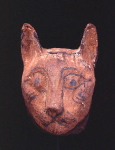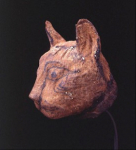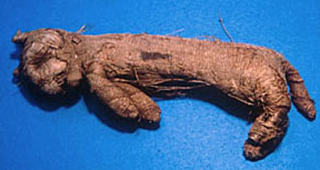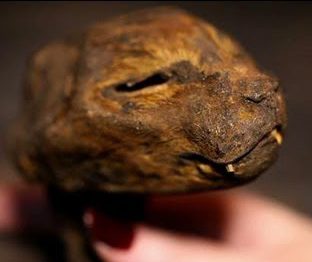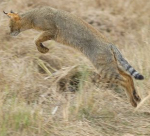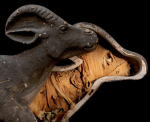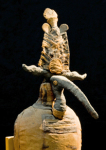In a A Cat Out of Egypt, Miw, the Egyptian temple cat who narrates the story, is in danger of becoming a cat mummy–and not as a result of a natural death. Several readers have asked whether such a thing could have been based in reality. This week’s blog is my answer.
How were cat mummies created in ancient Egypt? What significance did they have? What kind of process led to the creation of the vast cat cemeteries that archaeologists have discovered among Egyptian ruins? As with most historical questions, the answers are complex.
Cat Mummies as Votive Offerings
Cat mummies discovered in early excavations at Bubastis were probably the first to be seen by Western explorers/archaeologists, but the cat cemetery unearthed at Beni Hasan (a site roughly 100 miles south of Cairo and known for its beautiful tombs), was carefully described by a Western observer. In 1888, near the rock-cut temple dedicated to the lion goddess Pakhet, a huge cat cemetery was discovered. A lengthy description of the discovery follows, as recorded by British professor W. M Conway:

An Egyptian fellah from a neighboring village . . . dug a hole, somewhere in the level floor of the desert, and struck–cats! Not one or two, here and there, but dozens, hundreds, hundreds of thousands, a layer of them, a stratum thicker than most coal seams, ten to twenty cats deep, mummy squeezed against mummy tight as herrings in a barrel . . . A systematic exploration of the seam was undertaken. The surface sand was stripped off and the cats laid bare. All sorts and conditions of them appeared–the commoner sort caked together in black lumps, out of which here a grinning face, there a furry paw, there a backbone or row of ribs of some ancient puss, stood prominently forth. The better cats and kittens appeared in astonishing numbers, with all their wrappings as fresh as if they had been put into the ground a week, and not 30 centuries, before. Now and again an elaborately plaited mummy turned up; still more rarely one with a gilded face . . . only three cat statues have as yet been found. Two are small bronze figures. The third is a life-size bronze, a hollow casting, inside which the actual cat was buried . . . The plundering of the site was a sight to see, but one had to stand well to windward. All of the village children came and provided themselves with the most attractive mummies they could find. These they took down to the river to sell for the smallest coin . . . The path became strewn with mummy cloth and bits of cats’ skulls and bones and fur in horrid profusion, and the wind blew the fragments about and carried the stink afar . . . .
But most of the Egyptian cat mummies discovered in this and other such cemeteries in the late 19th century–nineteen tons of them–were bought in bulk and shipped to Europe to be sold at auction as fertilizer.
Who were these cats, and where did they come from? How did such huge numbers come to be packed into common graves–and sometimes even burned? Contemporary scholars agree that these cemeteries, always found in the immediate area of a temple dedicated to one of Egypt’s feline goddesses (such as Pahket at Beni Hasan, Bast at Bubastis, and numerous other sites as well), were filled with the mummies of cats purchased by pilgrims and given as votive gifts to the goddess. They had to be put somewhere.
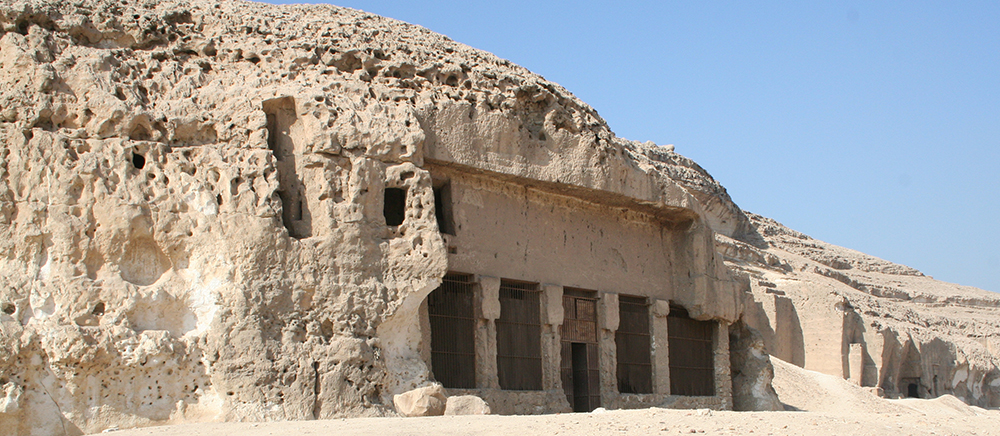
The cats discovered inside these mummy wrappings were the ancestors of today’s Egyptian Mau cats. Some are clearly identifiable as one of the two wildcat sub-species thought to have interbred to eventually produce Egypt’s domestic cats: the jungle cat, Felis chaus, and the African wild cat, Felis silvestris libyca.
What is a votive gift? We don’t see them much in Western Christianity today. The candles bought and lit alongside the altars in some churches are as close as most of us ever come to this ancient practice. The word “votive” here refers to something given or dedicated as an expression of a wish or desire. In Roman Egypt (which is when ACOOE takes place) the people believed that if they bought a mummified cat and presented it to the temple of a goddess like Bast/Bastet, or Pakhet, the cat’s spirit would join the goddess in the afterlife, where it would continually urge her to bless the giver and answer their prayer, whatever it might be. Of course millions of other animal mummies were given in the same way to their respective gods–snakes, fish, mice, gazelles, ibis, crocodiles, sheep, cattle, falcons, dogs, and even beetles.
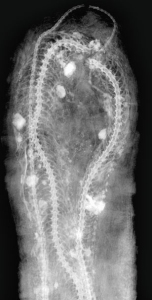
Recent research has shown that the popularity of votive mummies increased dramatically after 1000 BCE, when temples’ strict formality relaxed, and common people began to express their own personal piety. As the demand for votive mummies increased, priestly corruption and greed set in, resulting in “mummies” containing no animal at all, only a few bones, or parts of common animals substituted for the bodies of rare ones. In time, some animals came to be bred solely for the mummy trade.
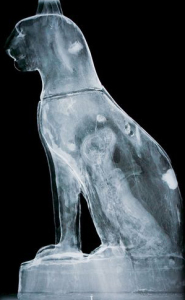
Particularly among the cat mummies from Bubastis, archaeologists have discovered a large proportion of young kittens, strangled or with broken necks, placed in adult-size wrappings. Cat remains from Bubastis that were apparently burned rather than mummified are still a mystery. (One tidbit of feline tradition in A Cat Out of Egypt explains such a fictional burning at Leontopolis).
As the description of Beni Hasan makes clear, the mummies in these cemeteries ranged from the ornate and artistically sophisticated to the very simple and carelessly made. The odor described at Beni Hasan certainly would have come from the less carefully-made mummies. Animals mummified as carefully as wealthy humans would have had little or no such odor. (In A Cat Out of Egypt, reference is made to the slip-shod embalming methods used in the production of some votive mummies)
A number of the mummies found in Egypt’s cat cemeteries were more carefully constructed. Many were beautifully painted and expensively wrapped. Some were enclosed in wooden caskets, often shaped as cats. Others were placed inside hollow-cast bronze cat figures. With these more complex figures we may be straying into the category of household pets embalmed and presented to the temple as votive offerings by their owners after death, although the presence of kitten mummies in some of these bronze figures (see above) may indicate their origin in the cat mummy trade. So in conclusion, we need to examine the different relationships that existed between cats and humans in early Roman Egypt, and how cat burials reflected those relationships.
Cats and their Egyptian Humans
Two early Greek historians are often quoted in discussions of ancient Egyptian cats: Herodotus (484-425 BCE) and Diodorus Siculus (1st C BCE), although their accounts should probably be approached with some caution. For instance, Herodotus states that it was the established habit of Egyptian cats to run into burning buildings; clearly his reports were not entirely accurate. Similar questions remain in his report of the battle of Pelusium, which, according to Herodotus, the Egyptians conceded to the Persians rather than risk killing the animals the Persians had staked out in their front ranks. How can the contradiction between the respect for ancient cats that both men reported, and the evidence of large-scale cat slaughter in the votive mummy industry be resolved?
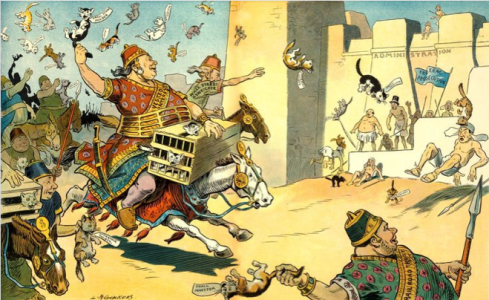
Perhaps this discrepancy can be explained by suggesting a kind of class distinction among Egyptian cats, at least as far as humans perceived them. The wild or feral cats who lived on the fringes of society would have been lowest in this order, little different from any other wild or domestic animal routinely hunted or raised for food, and probably bred for use in mummies. Second would have been the domestic cats kept as pets and mousers and generally respected as members of a species ennobled by the gods. Third were the sacred cats, whose status might have been determined either by specific markings–as in the case of the Apis bulls–or by their temple lineage. These cats were not worshiped, but held as sacred because in some way they were embodiments of the goddess. However they were identified, it was probably these cats who were so highly respected in Egypt that, according to Diodorus, a visiting Roman was lynched after accidentally killing a cat. Questions remain as to whether temple priests were permitted to kill cats considered to be sacred. Whatever the truth may be, Weguelin’s “Obsequies of an Egyptian Cat” (below) is likely to be a romantic over-statement.
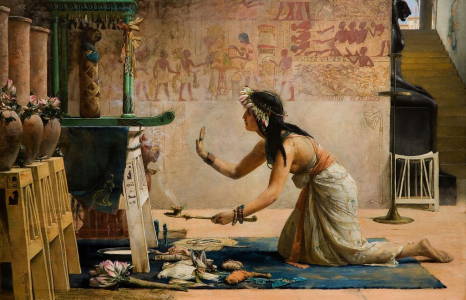
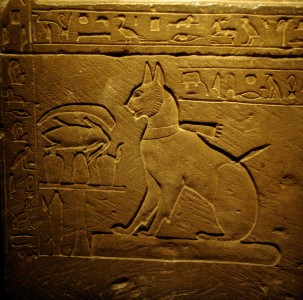
We do know that cats were treasured pets among the ancient Egyptians, and were frequently depicted in their owners’ tombs, as well as being buried with them. They were grieved by their humans as family members when they died. Perhaps the best known of all Egyptian pet cats is Tai Miuwette, “Little Mewer,” the cat beloved of crown prince Thutmose, brother of Akhenaten, whose stone sarcophagus has come down to us. We also know that sometimes these treasured pets were brought to the temples to be embalmed, and sometimes left as votive offerings–but only after natural deaths following long and pampered lives.
.
.
.

